How two new gas engine power plants in Chemnitz, Germany, are paving the path for a carbon-free future
When eins energie in sachsen decided to retire two coal-fired power plants in Chemnitz, Germany, in favor of new cogeneration plants, they were faced with a major question: How do you choose a future-proof power source for its newly built CHP plants? The solution would have to be cost effective, environmentally friendly, reliable and flexible enough to complement the energy transition.
By Moritz Gathmann
You can see it from a distance: The “Lulatsch” or “beanpole”, a colorful-striped chimney stack towering 300 meters over the Chemnitz-Nord coal-fired power plant and glowing like a beacon in the night sky. But soon, the puffs of smoke that still hang over the chimney in this industrial city two hours south of Berlin will stop – forever. From that point on, the Lulatsch will be a reminder that a new era of energy has begun.
Thanks to the project “New heat for Chemnitz”, commissioned by the local energy provider eins energie in sachsen, around a quarter of a million people here will soon get most of there heat and power from two new combined heat and power (CHP) plants, powered by MAN Energy Solutions gas fuel engine technology. The two new plants, MHKW Chemnitz-Nord and Altchemnitz, will supply the city with 150 megawatts of electricity and over 130 megawatts of thermal output – enough heat for some 40 percent of the population. “It’s a unique solution for maximum efficieny,” says Martin Domagk, Project Manager at MAN Energy Solutions.
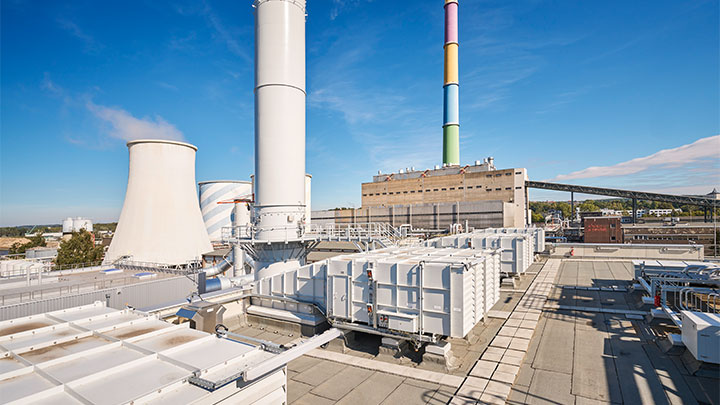
The end of an energy era: Soon the smoke over the rainbow-colored Lulatsch chimney stack will stop forever as eins energie replaces their coal-fired plant with an engine-powered CHP, reducing CO2 emissions by 60 percent. ©Anna Schroll
The engines can go from idle to full load in minutes.
Gas engines cut carbon emissions by 60 percent
As we walk through MHKW Chemnitz-Nord, Domagk explains what makes both new plants exceptional: the dynamic and highly flexible MAN 20V35/44G TS gas engines that power them. Here at MHKW Chemnitz-Nord seven such engines have been installed at the heart of seven separate machine halls, and another five at Altchemnitz.
“The engines can go from idle to full load in minutes,” says Domagk, “and each can produce nearly as much thermal as electrical energy.” Moreover, the engines make an effective use of their fuel, operating a total efficiency of up to 90 percent. “It’s an ideal solution for cogeneration plants.”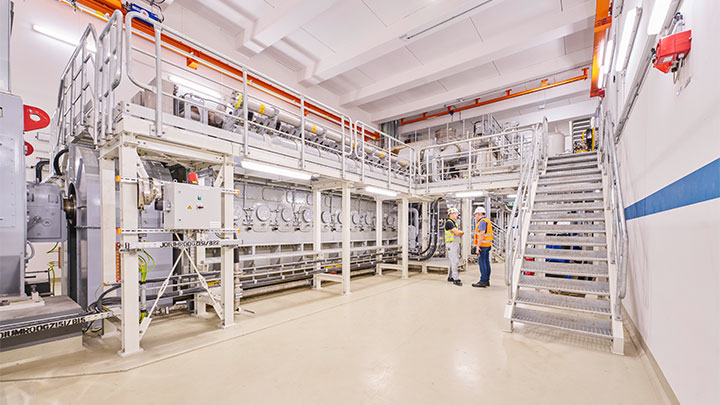
A total of seven MAN 20V35/44G TS engines, with an electrical output of 12.6 MW each, are powering the MHKW Chemnitz-Nord CHP plant in Chemnitz, Germany. ©Anna Schroll
Domagk points out the silver exhaust gas pipes leading out of the engines to the second floor of the machine halls. Inside these pipes waste heat with a temperature of up to 450 °Celsius coming from the combustion process within the engine heats up water flowing through various exhaust gas heat exchangers. However, it’s not only the energy from exhaust gas being used, but also the cooling water and even the heat from lubricating oil. “Compared to the older plant, these solutions reduce carbon emissions by around 60 percent,” says Domagk. “That’s like taking 260,000 cars off the road.”

The highly efficient gas engine CHP system for the new plants in Chemnitz produces nearly as much heat as power. ©Anna Schroll
How to choose power for a CHP
“For us, the quality of the engines and how they suit our Chemnitz-specific needs were the key factors,” says eins energie Project Manager Tino Schlemmer in his office on the old grounds. From the windows, you can hear the constant waterfall-like sound of the cooling tower of the old plant, but that too will stop in January 2024.
“The task was to find a solution that was environmentally sustainable, cost effective and offered a very high security of supply,” says Schlemmer. He and his team visited other similar CHP construction sites with MAN Energy Solutions or comparable engines at their core. “The visits convinced us of the engines’ efficiency, but also allowed to see what we wanted to do differently.” For example, eins energie chose to put each engine into a single machine hall, making it possible to repair an engine without affecting the operation of the others.
But that wasn’t the only consideration. They were thinking about the future too. Like many countries around the world, Germany is in the middle of an energy transition towards a carbon-free future that raises new challenges: Energy supplies and prices are becoming more volatile. And providers don’t know which energy sources will be readily available in the future or which technology is the right horse to bet on.
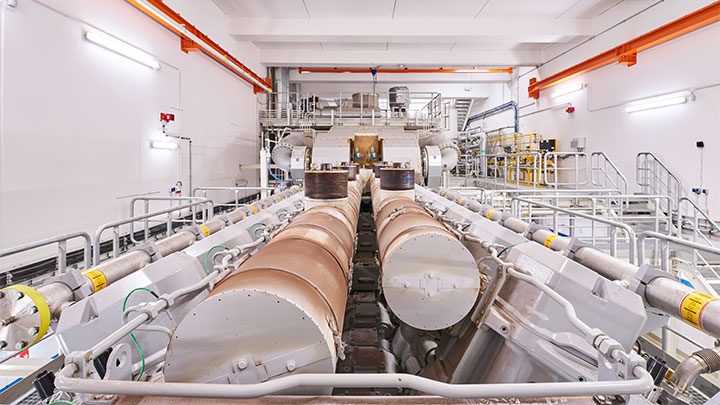
The MAN 20V35/44G can go from idle to full load in minutes with a total efficiency of up to 90 percent – making it an ideal solution for cogeneration plants. ©Anna Schroll
Why CHPs need flexibility in the energy transition
eins energie has set itself the goal to become a climate-neutral energy supplier by 2045 – with a focus on hydrogen, since Chemnitz is set to become one of the four hydrogen hubs in Germany. And the MAN Energy Solutions engines are helping
to set the path: The engines are a bridge technology, able to run now with an admixture of up to 25 percent hydrogen and MAN Energy Solutions is already developing new engines and retrofit packages to run 100% on hydrogen. Plus, they are able to run
with increasing shares of climate-neutral fuels such as biogas and synthetic natural gas (SNG) without modifications.
“Flexibility becomes even more important with the ongoing transition towards renewable energy, accompanied by the liberalization of the energy markets and the current political turbulences affecting the supply of some energy sources,” says Schlemmer. “So, we need plants that are quick to switch on and off and to control their power outputs.”
In comparison to the old coal-fired plant, which would take hours to restart, the pre-warmed engines need less than three minutes to deliver 100 % electrical output, and only a few minutes more to produce thermal energy. “Quick startup and shutdown times allow the plant to react to sudden load variations in the grid,” says Domagk. This allows them to provide seasonal, dispatchable power generation when renewable energy isn’t available.Flexibility becomes even more important with the ongoing transition towards renewable energy.
Tailoring a CHP system for the future
Both cogeneration power plants also come with sophisticated control engineering technology, points out Domagk, which allows eins energie to easily adjust to the needs of the grid: In summer, for example, when prices for electricity are high but heat isn’t needed in significant amounts, the plant focuses on providing power – in the winter, on providing heat. “Let’s say, eins energie knows the network needs 50 megawatts of electrical power. You enter the needed amount, and the engines adapt to it. The same goes for thermal energy,” says Domagk.
While here, in the north of Chemnitz, the coal-fired plant is making room for a modern gas-fired power plant these days, eins energie is already investing in energy production like wind energy, solar energy, and has further plans to add in heat pumps and electrolyzers for the production of hydrogen. But until more green hydrogen is available, gas-fired power plants remain an important step in the energy transition. Switching from coal to gas quickly cuts emissions in the short term, and the plants enable the continued expansion of renewable energy, closing the supply gap on days when there is little or no sun and wind. “We’re convinced that gas-fired plants will play a decisive role for a long time,” says Schlemmer, “They guarantee security of supply.
About the author
Berlin-based journalist Moritz Gathmann has been reporting as a correspondent from various regions of Europe for German publications since 2004. His work has been published in DER SPIEGEL magazine, Frankfurter Allgemeine Zeitung, and other media.
Reducing emissions with CHP
The smart use of combined heat and power (CHP) gives you the opportunity to decarbonize your gas-based energy production cleverly and efficiently. CHP is a flexible solution that allows for the integration of renewables and energy storage technologies to further lower your carbon footprint. And heat is not just for keeping warm. Process industries use CHP to produce cold and high-quality steam. And since CHP plants are usually located close to the end user, transport costs and distribution losses are low.
Explore more topics
-

The latest-generation wind turbine installation vessel
A new wind turbine installation vessel with a customized-engine configuration lets offshore wind contractor Cadeler transport and lift more powerful turbines in even rougher locations – and they’re saving emissions while they are at it.
-
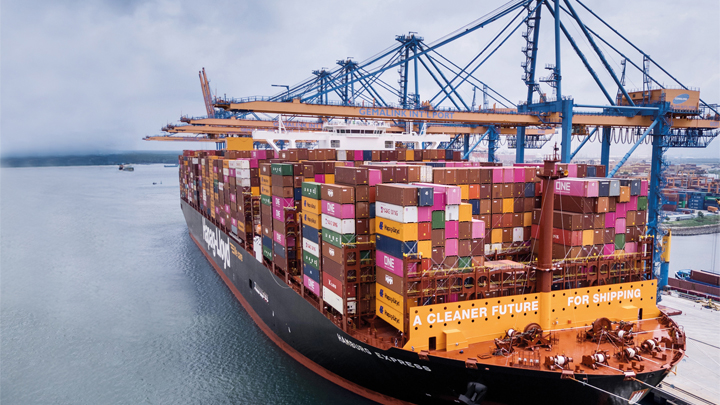
Hapag Lloyd LNG container vessel
Hapag-Lloyd’s new LNG-powered containership cuts emissions by a quarter immediately and by 95 percent with green methane
-
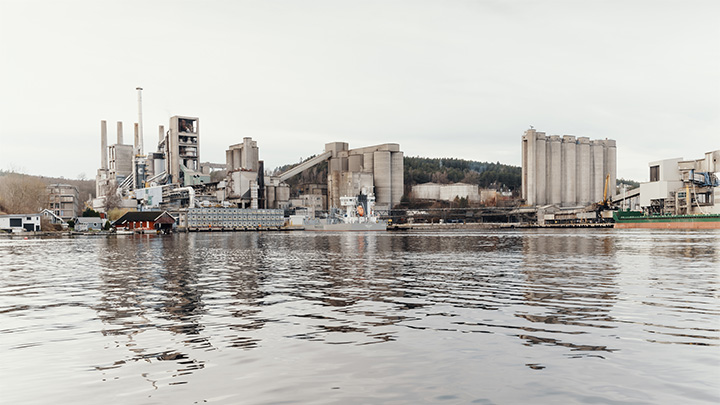
Heidelberg Materials: First CCS plant for cement industry
The first CCS facility for cement production in Brevik, Norway, is paving the way for carbon-neutral industrial processes.
MAN Energy Solutions is now Everllence.
We have adopted a new brand name and moved to a new domain: www.everllence.com. This page will also be relocated there shortly. We are working on shifting all pages to www.everllence.com.
